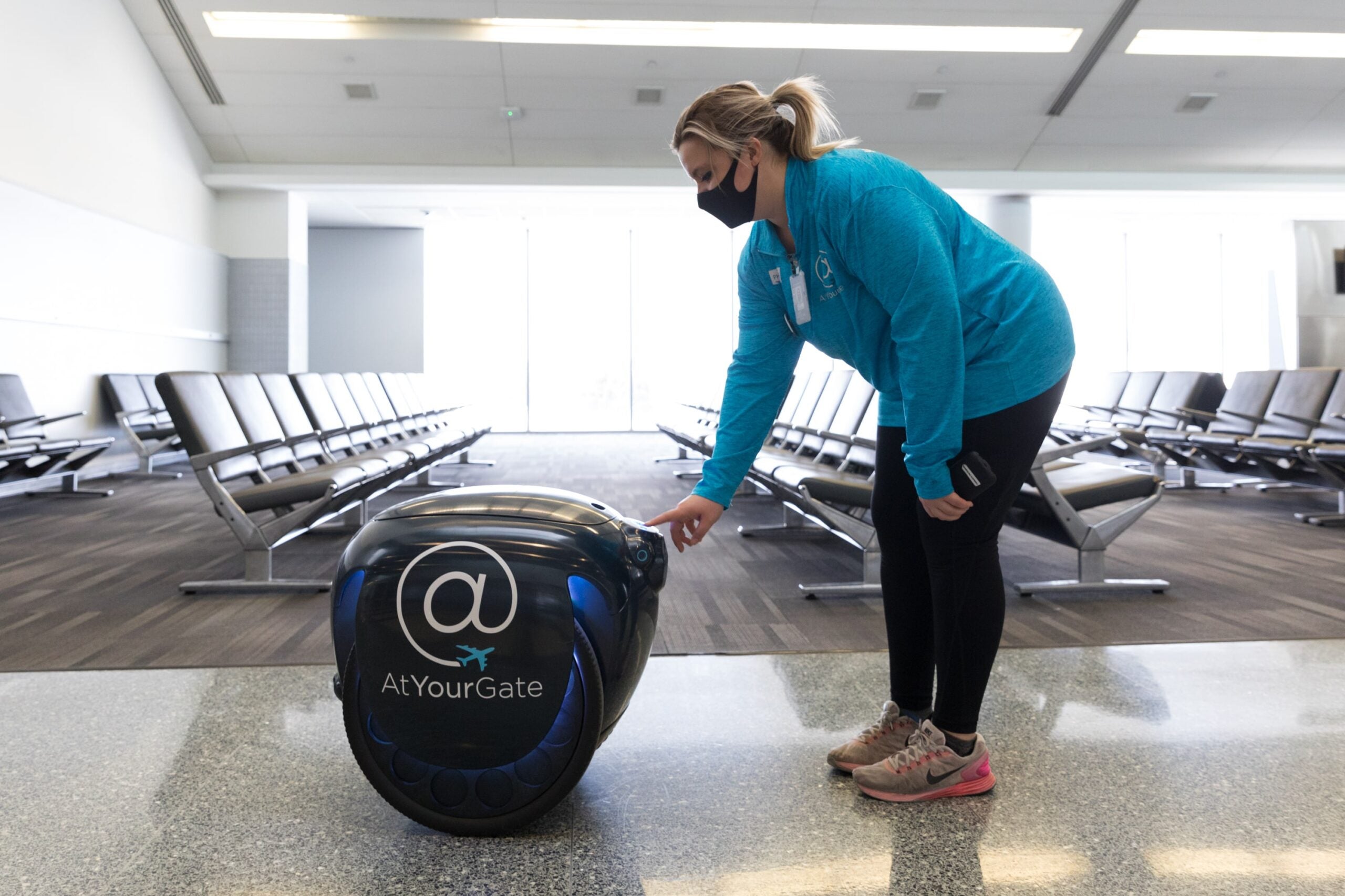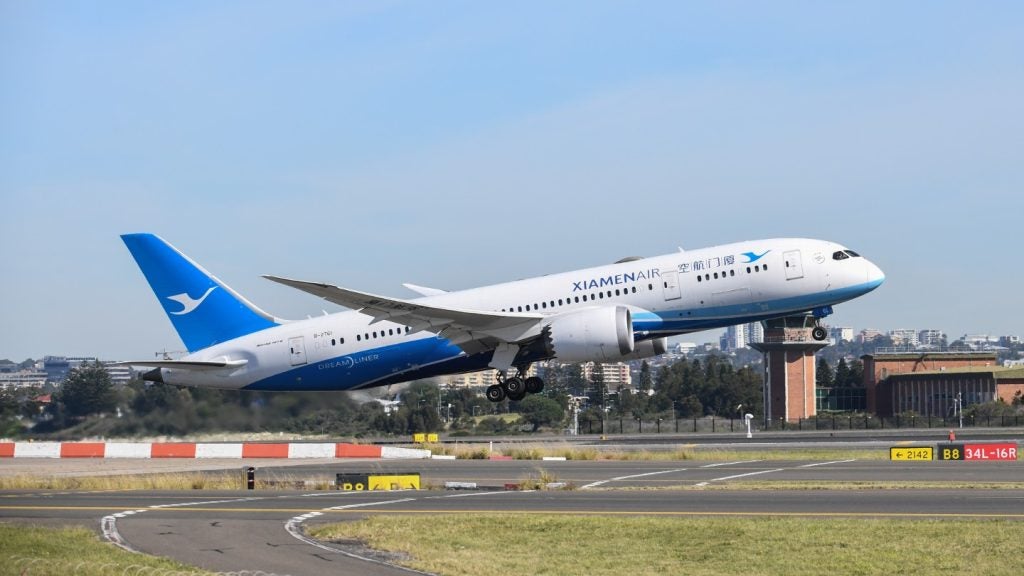
A survey carried out by Air Transport IT Insights recently found that almost half of global airlines and 32% of airports are currently looking for partners to further develop their robotic involvement in the next three years. The latest developments see robots staffing airport check-in desks, carrying out security protocols, cleaning and even delivering food to passengers.
The airport security segment currently has the highest number of robots according to the Airport robots market – growth, trends, Covid-19 impact, and forecasts 2021-2026 report by Mordor Intelligence. The next most common use of airport robotics is for cleaning, which has seen a rise in demand due to the Covid-19 pandemic.
Meet Philadelphia International Airport’s new team member
PHL Food and Shops have introduced a new member to their team Philadelphia International Airport, Gita. Standing 26 inches tall and able to carry up to 18kg for four hours – which is the equivalent of 20 miles of walking – on one single charge, Gita navigates busy, pedestrian-filled locations with human-like etiquette. Gita has been tasked with delivering food orders to airport passengers while they wait in lounges for their flights.
PHL already had a contactless ordering system in place that allowed customers to order food. Now the company has partnered with app developer AtYourGate and Gita’s developer Piaggio Fast Forward to have Gita complete the process with automated delivery.

How well do you really know your competitors?
Access the most comprehensive Company Profiles on the market, powered by GlobalData. Save hours of research. Gain competitive edge.

Thank you!
Your download email will arrive shortly
Not ready to buy yet? Download a free sample
We are confident about the unique quality of our Company Profiles. However, we want you to make the most beneficial decision for your business, so we offer a free sample that you can download by submitting the below form
By GlobalDataCustomers at the airport can confirm food delivery from any of the 19 restaurants and retailers currently part of the scheme via an app or the PHL website. Once prepared, onsite delivery specialist Claire Maddocks collects the order and escorts Gita the robot who carries the to the customer.
MarketPlace PHL marketing and customer service manager Megan O’Connell explains that the robot not only helps carry large orders but also provides a contactless experience for customers. This offers the added advantage of reducing the possibility of Covid-19 transmission.
O’Connell explained. “There are some questions about what the point of the robot is because it does have to have a person with it. I explain to people that the point is not only does this robot help Maddocks carry the food, but the biggest part of it is also that it gives the customer a choice of whether they want to have contact or not with her.” O’Connell said. “If they don’t want to have contact with her, she can walk up with the robot, open the lid and [then] she can retreat back, the person can take their food out of the robot without ever having to interact with her.”
PHL hopes the option of using Gita will increase customer confidence post-pandemic and will increase the consensus surrounding public safety and confidence in coming back to the airport.
O’Connell expanded. “I hope that everything we’re doing across the board and the aviation industry is starting to make people feel safe and have confidence in coming back to the airport. With initiatives like this, we truly are doing everything we can to make them feel comfortable. We can’t wait to have everybody come back when they feel like it’s the right time.”
The robots carrying out health and security checks
Robots are also being used to ensure passenger safety by carrying out health checks, cleaning protocols and security measures.
A security robot in the form of a scooter has taken residence at Hamad International Airport in Qatar. With built-in cameras that can measure pulse rate, carry out face recognition, and sensors to detect fake credit cards and currencies, this security scooter robot is heavily equipped to ensure security measures are always upheld.
The robot can even sense a passenger’s mood with an algorithm that enables it to detect a high body temperature, heart rate and stress levels to detect if a passenger is nervous or agitated.
Cleaning robots are also having their day. Heathrow Airport has been using cleaning robots around the airport terminals and lounges that disinfect areas using UV light. UV light has been shown to efficiently kill harmful viruses and bacteria to provide a safe, secure environment for passengers.
Heathrow Airport process improvement director Mark Burgess heads up the ‘Fly Safe Programme’ at the airport. He explained: “The UV robots disinfect surfaces using UV-C light. Depending on the exposure time, a UV robot can kill up to 99.9% of pathogens by disinfecting all surfaces which could harbour bacteria and viruses. The UV-C light used by the robots is highly efficient and can disinfect 18,000 sqm within a two and a half-hour time period.”

Heathrow wants the cleaning robots to offer a high level of assurance and confidence in hygiene for customers and staff.
“The UV robots have proven to be an incredibly useful tool within our enhanced cleaning programme, helping to ensure we disinfect the terminals on a regular basis,” Burgess said. “We believe the UV robots currently complement our existing cleaning method and they are an additional measure within our process which help to keep Heathrow Covid-secure. Their speed and ability to sanitise ultimately enables our cleaning technicians to carry out our intensive cleaning programme with greater efficiency and ease than previously.”
Looking into the robotic future
With technology developing at a rapid rate, an increasingly robotic future seems assured for airports.
However, their use raises some important questions and security hurdles. Could the robot accidentally hurt passengers? Will it malfunction? Will it correctly carry out the duties autonomously? Is passenger data secure, not least when it comes to judgement calls on health and mood?
The use of robotic technology in airports is likely to increase but gradually, with certain models having to be accompanied by a staff member before turning completely autonomous.
O’Connell explained: “The challenge with the airport is it’s a condensed space. I do think that there are going to be a lot of considerations in the future for implementing robotic strategies where necessary and where it makes sense. It’s going to take a lot of work because there are just so many moving pieces to making sure it’s safe. I think there’s a place for it and I think more people will start to adopt it but it’s going to be slow.”
As technology continues to progress and develop, paired with a growing interest in the robotics market by the aviation sector, we can expect to see more robotic assistance at our airports in the years to come. With robots offering many benefits such as faster check-ins, increased security and a personalised experience for customers, robotic-led terminals could be the future of aviation.





